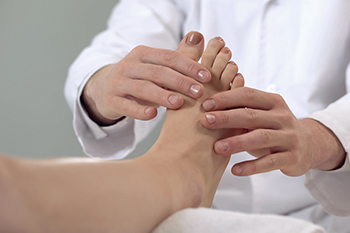
A bunion, known as hallux valgus, is a bony bump that occurs on the joint of the big toe. It forms from bones in the top part of the foot moving out of place, which causes the tip of the big toe to be pulled toward the smaller toes. It also forces the joint in the big toe to be stuck. Women and elderly people are most apt to suffer with bunions. These rarely occur in children, but sometimes babies are born with bunions, or they form in later childhood. The skin above the bunion might be sore and red. Bunions can form by wearing narrow or tight shoes, from one’s foot shape, way of walking, a medical condition, or a foot deformity. Calluses might develop where the big and 2nd toe touch, or on the ball of the foot. Bunion pads, well-fitted shoes, or toe spacers might help with bunion discomfort, and if not, bunion surgery (a bunionectomy) might be an option. Untreated bunions may get worse over time, and it might be difficult to walk or wear regular shoes without pain. If you have a bunion and it hurts, contact a podiatrist for the best treatment option for you.
If you are suffering from bunion pain, contact one of our podiatrists of Comprehensive Footcare Clinic - Hawaii. Our doctors can provide the care you need to keep you pain-free and on your feet.
What Is a Bunion?
Bunions are painful bony bumps that usually develop on the inside of the foot at the joint of the big toe. As the deformity increases over time, it may become painful to walk and wear shoes. Women are more likely to exacerbate existing bunions since they often wear tight, narrow shoes that shift their toes together. Bunion pain can be relieved by wearing wider shoes with enough room for the toes.
Causes
- Genetics – some people inherit feet that are more prone to bunion development
- Inflammatory Conditions - rheumatoid arthritis and polio may cause bunion development
Symptoms
- Redness and inflammation
- Pain and tenderness
- Callus or corns on the bump
- Restricted motion in the big toe
In order to diagnose your bunion, your podiatrist may ask about your medical history, symptoms, and general health. Your doctor might also order an x-ray to take a closer look at your feet. Nonsurgical treatment options include orthotics, padding, icing, changes in footwear, and medication. If nonsurgical treatments don’t alleviate your bunion pain, surgery may be necessary.
If you have any questions, please feel free to contact our office located in Honolulu, HI . We offer the newest diagnostic and treatment technologies for all your foot care needs.
